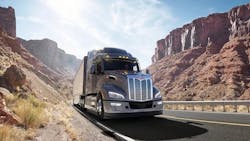How integrated powertrains, engine controls impact fuel efficiency
This is Part Two of a three-part story.
While Class 8 trucks need a lot of fuel to keep them going, how fleets choose to maximize their fuel efficiency can help steady the financial shock of fueling up at the pump. In Part One of this story, we discussed how some of the newest sleeper trucks are designed to sip fuel instead of guzzle it.
While fuel efficiency gains can be made through exterior embellishments, such as aerodynamic tools and cab designs, interior developments to the powertrain, engine, and more can help fleets control their fuel costs.
Integrated powertrains
Engine manufacturers have been making hardware improvements over the past few years to help boost fuel efficiency.
“Today’s engines have revolved around the goal of reducing parasitic losses while optimizing their handling system in an area of the fuel map where a truck spends a high portion of its drive cycle,” said Kris Ptasznik, powertrain TCO and consultancy leader at Cummins, a manufacturer of engines, emission solutions, and other products for commercial vehicles. “The engine must be more efficient where the transmission ratios, axle ratios, and tire sizes all say the engine is going to operate most of the time.”
To that point, the concept of an integrated powertrain has helped truck manufacturers ensure that all components work in harmony, helping improve performance while lowering fuel consumption.
“The industry had gotten used to getting the engine over here and the transmission over there, putting together their own little Frankenstein,” said Len Copeland, Detroit product marketing manager. “Not anymore. Without the integration we have today, you could never get the accuracy, speed, and efficiency that’s required of vehicles now.”
The integration of Detroit’s powertrain, for example, extends beyond conventional electronic communication protocols (such as SAE J1939). It leverages a common controller capable of operating at faster speeds. “This enhances operational smoothness, a critical factor in optimizing efficiency,” Copeland said, while also offering a couple specific examples.
“The Detroit DT12 (automated manual transmission) can achieve 20-40% quicker shifts in gears 7 to 12. This improvement is achieved by reducing torque interruption and maintaining turbo boost, resulting in smoother shifts and enhanced efficiency. Moreover, precise clutch control eliminates the need for a self-adjusting clutch, while Power Launch technology accurately targets torque requirements for smoother launches, rather than relying solely on preset RPM thresholds,” Copeland said.
Integrated powertrains have opened the door to engineering techniques like downspeeding. Downspeeding uses faster rear axle ratios to allow for lower engine speeds. According to data from the North American Council for Freight Efficiency (NACFE), downspeeding can help improve fuel efficiency by 2-3%.
“Rear axle ratios have historically been run at 3.25,” said Brian Antonellis, SVP of Fleet Operations at Fleet Advantage. “But that was before direct-drive transmissions and the torque bands we see now. Now we’re seeing some fleets go down to as low as 2.38 in some instances.”
Copeland explained that “trucks equipped with higher axle ratios, like 3.08, often operate at around 1,300 rpm, while those with lower ratios, like 2.85 or 2.64, can achieve lower rpm ranges of 1,200 and 1,100, respectively.
“Historically, reducing rpm by 100 can yield an approximate 2% fuel savings, making the transition from a 3.08 to a 2.64 a potentially instant return on investment,” he continued. “However, it’s crucial to note that this calculation applies when comparing similar transmission types (i.e. direct drive with direct drive).”
Axle configuration is also an important consideration. When operating in environments where drivers don’t necessarily need power to both rear axles, spec’ing a 6x2 axle could help improve fuel efficiency by 2.5% compared to a 6x4, according to data from Cummins.
Engine parameters and electronic features
Electronic engine parameters also present some fuel-efficiency opportunities. In fact, NACFE said a fleet could see an improvement of 5-8% by optimizing certain parameters such as vehicle speed control, predictive cruise control, and idle shutdown. Gear-down protection is also helpful, as long as the transmission is set up properly and the speed sensors are tuned correctly.
“There are many different parameters that can all dance together as a truck is driving down the road,” Cummins’ Ptasznik pointed out.
The Cummins X15 Efficiency Series (2024) engine, which is available on many of today’s sleeper tractors, can provide up to a 1% improvement in fuel economy when comparing powertrain configuration to the 2021 product. The incorporation of EX Ratings provides an additional 1.75% in certain duty cycles. Cummins EX Ratings help ensure powertrain optimization by harmonizing the Cummins engine, Eaton Endurant HD transmission, and GPS look-ahead data. That integration allows for several unique features that can help fleets maximize fuel efficiency.
Read more: With Cummins' newest X15 engine, diesel still at the 'HELM'
“Look at predictive gear shifting, for instance,” Ptasznik said. “The engine is downsped, so it doesn’t maintain speed on a grade like it used to. This feature knows it’s going to have to downshift at some point on a hill. It also knows it can carry speed better by downshifting earlier, instead of shifting on the grade and losing even more speed during that shift event. Then it will command the transmission to perform an early upshift when it’s cresting that grade, allowing the driver to reaccelerate back to set speed in a more efficient manner.”
No unique calibrations are required for fleets to enable EX Ratings features, which include On-Ramp Boost, predictive engine braking, dynamic power, and hill roll out. New in 2024 is an addition to Cummins’ SmartCoast functionality.
“If it knows it can recover speed loss at the bottom of a hill, it will just coast instead of upshifting,” Ptasznik explained. “The truck may lose a little speed. But the system knows, through the predictive map data, that gravity will help that truck get back up to speed.”
Aero accessories
Aerodynamic features are also important to fuel efficiency, but shouldn’t be taken for granted when spec’ing a new truck. Although it’s pretty rare, NACFE Executive Director Mike Roeth said fleets can still buy sleeper tractors without skirts. It’s important to confirm which aerodynamic features are standard and available as options when spec’ing a new truck.
“If you’re an OTR fleet, it’s all about closing air gaps,” Fleet Advantage’s Antonellis said. “You want as short an air gap as possible between the front of the trailer and the back of the fairings. You want to close gaps around the wheels, tanks, and fenders.”
At 70 mph, nearly two-thirds of the energy created by the engine is spent overcoming aerodynamic drag, noted Daniel Burrows, VP and general manager of TruckWings at ConMet. TruckWings is a tractor-trailer closure device that activates automatically at highway speeds and retracts under 50 mph to allow the truck to turn. ConMet acquired the company last November.
Testing by Mesilla Valley Transportation Solutions found fuel efficiency improved by 6.2% on a diesel truck equipped with TruckWings versus one that did not.
MVTS testing also revealed FlowBelow’s OEM quarter fender replacement, AeroFender, can cut fuel usage by 187 gallons of fuel per year (1.49 gallons per 1,000 miles).
“A bonus to the AeroFender is that fleets can subtract the cost of the OEM quarter fender they are currently spec’ing, which reduces the purchase cost and improves the ROI of the AeroFender even more,” noted Daryl Bear, lead engineer and COO of MVT Solutions.
Idle reduction
Excessive idling is a fuel economy killer. Various electronic engine parameters can help address idling while trucks are stuck in traffic or at a port. According to NACFE’s Benchmarking tool, 93% of OTR fleets utilize anti-idling electronic engine controls.
“Fleets should also make sure any truck they’re buying has some idle-reduction technologies like engine start/stop,” said Roeth. “Cruise control is another important feature. And, of course, fleets have to look at things like aerodynamics and tires. These are the types of things that can help take a truck from 6 to 8 mpg.”
But when it comes to sleeper tractors, other technologies and products must come into play.
“This might be the time to jump into a diesel or battery-electric APU (auxiliary power unit),” Roeth noted.
Bunk heaters, for instance, use a fraction of a gallon of fuel to run all night. Similarly, APUs can be used to run air conditioning and other cab accessories while the truck engine is turned off. APUs also use far less fuel than idling. Plus, there are even battery-electric versions available.
In Part Three of this story, we explore how tires, wheels, and engine oil can do their part to up sleeper fuel efficiency.
About the Author

Gregg Wartgow
Gregg Wartgow is a freelancer who Fleet Maintenance has relied upon for many years, writing about virtually any trucking topic. He lives in Brodhead, Wisconsin.
